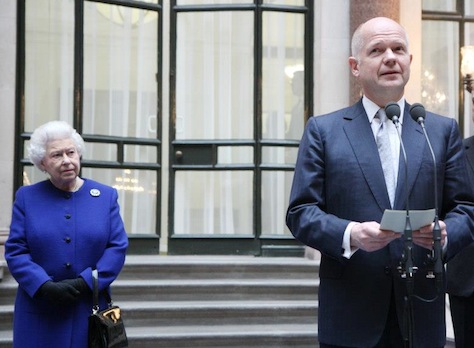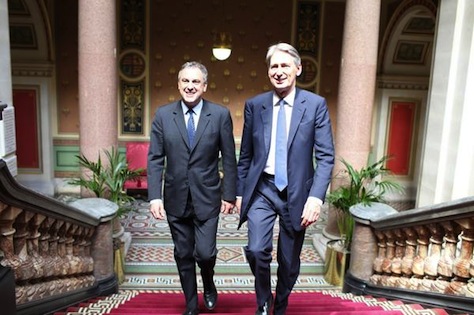It wasn’t a surprise that British prime minister David Cameron sacked Kenneth Clarke, the one-time self-proclaimed ‘big beast’ of the Conservative Party from government. ![]()
At age 74, the pro-Europe former chancellor, who began his ministerial career in Edward Heath’s government of the early 1970s, had already been demoted once from justice secretary, his progressive ideas for penal reform and lighter sentencing guidelines thwarted by the Tory right two years ago.
But it was something of a surprise that Cameron sacked so many other high-profile members of his cabinet last night.
Foreign secretary William Hague (pictured above with Queen Elizabeth II), one of the most high-profile Tories inside or outside government will now become the Commons leader. Hague, once a strident eurosceptic, was elected leader of the Conservative Party in the aftermath of Tony Blair’s massive victory in 1997. He stepped down in 2001 after his failed campaign to return the Tories to power. Though just 53 years old, Hague also announced he would also leave office at the 2015 elections, cutting short what’s been a solid career, if not one that might have elevated Hague to the premiership under different conditions.
His replacement is defence secretary Philip Hammond, another Conservative firebrand, who has ably worked with chancellor George Osborne to reign in spending while the United Kingdom has reduced its role in the US-led occupation in Afghanistan. Hammond, who served as Osborne’s deputy in opposition, comes from the right wing of the party, however, having opposed Cameron’s push to legalize same-sex marriage last year. He’s not known as a particularly charismatic figure, and he’ll have a hard time shaking the notion that he’s No. 11’s man at the foreign office.
Having argued that the United Kingdom should leave the European Union without significant, additional British carve-outs, Hammond will now be tasked with salvaging the UK-EU relationship.
But the knives went longer and deeper still — David Willetts, the minister for universities and science, nicknamed ‘Two Brains’ and deemed one of the cabinet’s most thoughtful members; David Gove, the combatively conservative and stridently eurosceptic education minister; Dominic Grieve, the attorney general; Owen Patterson, the environmental secretary.
The semi-official word is that Cameron’s reshuffle represents an effort to put his cabinet and his government on footing to wage next May’s general elections, with a particular focus on elevating the number of women and younger Tories to higher positions.
To borrow a phrase from former US president Bill Clinton, a ‘cabinet that looks like Britain.’
Labour leader Ed Miliband is already foaming that the reshuffle is a ‘massacre of the moderates,’ but that seems as inaccurate as it is reactive.
Hague is a moderate only through the moderation that high office brings. It’s the same person whose failed 2001 campaign rallied around the slogan, ‘Save the pound,’ hardly much different from the eurosceptic fulminations of Nigel Farage, the rising leader of the United Kingdom Independence Party (UKIP), which won the most support across Britain in May’s European parliamentary elections.
Gove is as conservative as they come, and he arguably tried to nudge Cameron even more to the eurosceptic right when he announced last May that he would vote to leave the European Union. Though he’s been demoted in the current reshuffle, his new position of chief whip is hardly insignificant. Ask Francis Urquhart.
Paterson, who’s raised eyebrows as a sceptic of climate change, has long been a target of environmental activists. Green voters will be happy to see him go. Further reports indicate some former right-wing leadership aspirants, including Liam Fox, who briefly served as defence secretary from 2010 to 2011, turned down offers to return to cabinet. Another key member of the Tory right, the 60-year-old Iain Duncan Smith (Hague’s failed successor as Tory leader), as much a ‘boring, middle-aged white male’ as any in government today, will remain in cabinet as welfare reform secretary.
The most curious aspect of the reshuffle is that Cameron would take such a drastic step when his chances for a second term are as strong as they’ve ever been. The latest Guardian/ICM poll, taken July 11-13, shows that the Tories are rising — with British voters now turning their focus away from the European Union and more toward an array of domestic issues, UKIP’s support is melting. The Tories now lead with 34% to Labour’s 33%, the Liberal Democrats (the junior partners in Cameron’s government) win 12%, and UKIP wins 9%. It certainly seems that voters are having a hard time picturing Miliband, with a style more Kinnock than Blair, as a potential prime minister. Ten months is a long time, but the trend over the past two years has been a revival of Tory fortunes.
Everyone knew a reshuffle was coming, and the message is certainly clear that Cameron is culling the cabinet of ‘dead white males,’ but it’s not clear why it needed to be so deep and so severe.
The answer might be that the reshuffle is designed not only to put the cabinet on an election footing, but also to prepare it for the coming battle over the UK’s role in the European Union.
The Guardian‘s Patrick Wintour suggests that Hammond is a placeholder, and that currently chancellor George Osborne will be in line to take over as foreign secretary if the Tories win the 2015 elections. The Telegraph‘s Iain Martin, however, believes that Hammond’s selection has more to do with the coming negotiations that Cameron has promised to open with EU leaders about clawing back certain powers from Brussels to London in advance of a promised 2017 referendum on continued British membership in the European Union:
This… is about Cameron getting ready for the renegotiation with the EU, a subject in which Hague (knowing he wasn’t going to be around) has taken too little interest. Hammond is tough, and indeed he has been appointed to be much tougher with the pro-EU elements in the FCO machinery and to start the process of working out what a renegotiated settlement actually looks like.
Both arguments could ultimately be true, and it would certainly not hurt EU negotiations to have Osborne, as foreign secretary, and Hammond, as chancellor, double-teaming likely new European Commission president Jean-Claude Juncker throughout 2015 and 2016.
The appointment of Lord Hill of Oareford, the current leader of the House of Lords, as Cameron’s choice to become the next European commissioner, is also instructive. Hill, a former political secretary in John Major’s government in the 1990s, is a quiet and effective behind-the-scenes functionary who will be vital to smoothing UK-EU relations in what will certainly be a difficult patch between now and 2017. His first task will be patching up relations with Juncker after Cameron led a failed push to deny Juncker the European Council’s nomination for the Commission presidency last month.
Cameron, in the next three years, faces two referenda that will invariably come to define his legacy — the September Scottish independence vote and the proposed 2017 EU membership referendum. With polls showing that Scottish voters are still unlikely to separate from the United Kingdom, Cameron is already moving to secure the negotiations team that will give him the leverage to convince British voters that EU membership is vital to British interests. That will be a difficult sell, and if Cameron fails, history will remember him for little more than being the prime minister who presided over the UK-EU divorce, hardly a palatable legacy.
Institutionally, one of the most important changes involves the sacking of Sir Bob Kerslake as head of the civil service, with cabinet secretary Sir Jeremy Heywood replacing him. Cameron split the offices of cabinet secretary and head of the home civil service in 2012, and Heywood’s appointment means that the two offices will be reunited once again. It’s a sign that Cameron will now turn to civil service reform in the last year of his first term and in any second term.

